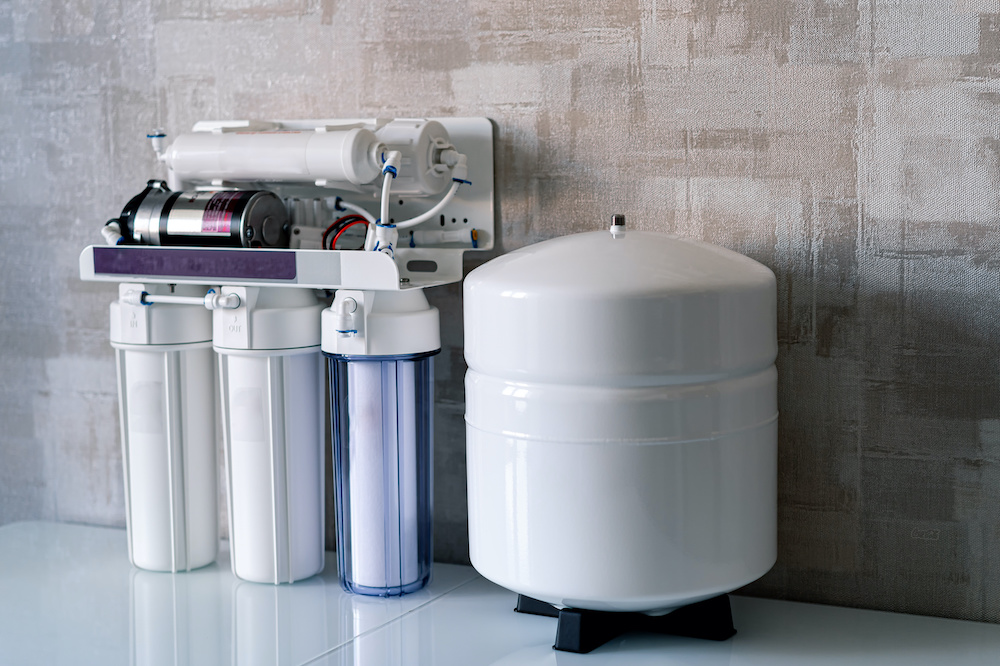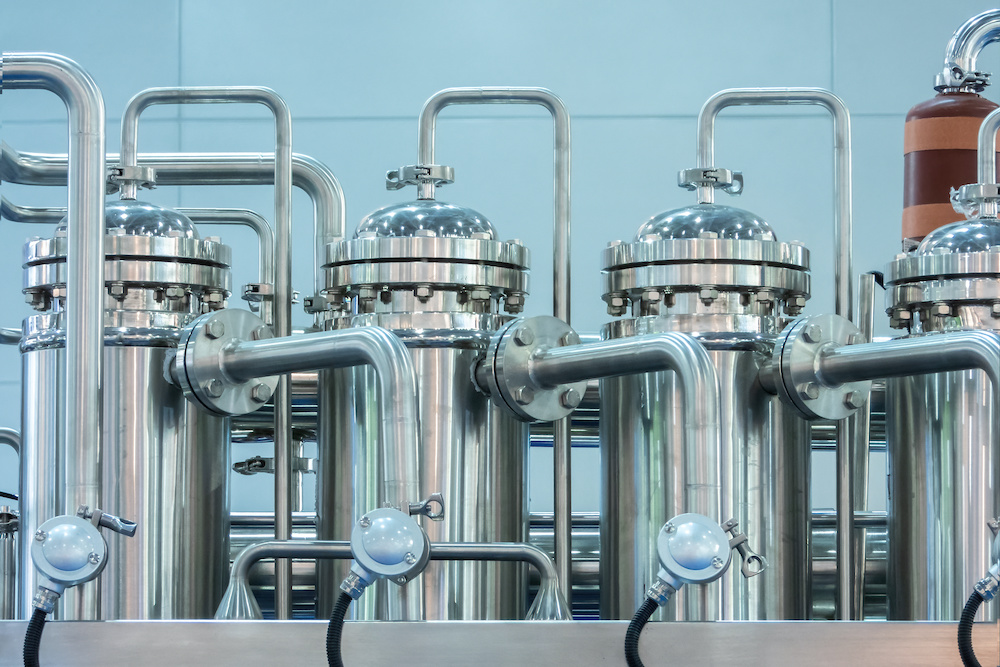Water purification is an important aspect of a homeowner’s life.
Considering your budget, health, and practicality, you’ll have to decide which works better, a distiller or a reverse osmosis (RO) system.
While both purify water effectively, a distiller takes some time to prepare, while an RO system does it instantly.
Let’s discuss further the differences between distiller vs reverse osmosis systems.
We’ll also discuss their by-products, mechanical and chemical processes involved, and pros and cons.
Distiller vs Reverse Osmosis
Distillers and reverse osmosis systems purify water using different methods.
While both are effective for their main purposes, one might be better at different aspects than the other, depending on the purpose.
Distillers and Distillation Explained
Distillers are self-enclosed systems that purify water by heating it to its boiling point, collecting its steam, and condensing it back to its liquid state.
This process, called distillation, effectively removes all contaminants and other impurities.
The rolling boil kills bacteria, and the steam leaves sediments, heavy metals, and other pollutants since they cannot turn into steam in water’s evaporation process.
When the water turns from a liquid to a gas in a separate collection chamber, these contaminants stay in the boiling chamber to be discarded.
While early water distillation systems were rudimentary steam collection pots, modern distillers were more sophisticated.
They now come in different sizes with varying distillation times and features such as automatic on-and-off and self-cleaning functions.
Benefits of Distilled Water
Here are some of the best things about distilled water:
- Virtually No Contaminants
Distilled water has been dubbed as the purest water for a reason: it has virtually no contaminants when done right.
Using proper instruments, water distillers can remove up to 99.99% of contaminants, such as volatile organic compounds, pathogens, and sediments.
As such, your chances of getting sick from waterborne diseases are significantly lower when you use distilled water.
Also, distilled water is a form of soft water since the distillation process removes hard minerals such as calcium and magnesium in the process.
It means that it shouldn’t form scales that clog electrical appliances, stain metal or glassware, or irritate sensitive skin.
This makes distillation the best purification method for water used in medical fields.
- Potentially Healthier Drink for Some People
Doctors also advise patients with certain diseases or compromised immune systems to drink distilled water.
Since unfiltered tap water may still contain contaminants, it’s best to err on the side of caution and use contaminant-free water instead.
Some professionals in the medical field also believe that distilled water’s lack of mineral content aids in washing away calcium deposits in joints.
That’s something especially helpful with patients suffering from arthritis.
This lack of mineral content may also lessen your chances of contracting kidney stones, which primarily happen when mineral deposits remain in your kidneys.
- Easily Absorbed by the Body
As the purest water, distilled water has been scientifically proven to pass through our bloodstream easily when consumed.
This makes it the ideal drinking water for athletic or strenuous activities.
With its lack of contaminants, it can’t hamper the body’s natural water absorption abilities.
Also, since the human body excretes water waste and excess minerals such as salt through urination, drinking water with excessive mineral content can make you urinate more, hence, dehydrated.
Still, remember that a complete lack of electrolyte minerals after hard activities has significant repercussions. Thus, you must replenish them through other means.

The Disadvantages of Distilled Water
With all the benefits to be had from distilled water, here are some drawbacks to distilled water:
- Lacks Minerals
As mentioned, due to its high purity, distilled water has no essential minerals, such as zinc, potassium, calcium, sodium, magnesium, and phosphorus.
Although you can safely drink distilled water, it becomes dangerous if you don’t get your daily mineral needs through other food or supplemental source.
An example of a disorder caused by a lack of healthy minerals is electrolyte imbalance.
Electrolytes are essential minerals that aid in bodily functions.
Lowering their levels can cause you to become irritable, develop muscle cramping, and experience mild to moderate nausea.
Moreover, the water supply in the US contains added fluoride intended to aid in dental health.
That is because fluoride can be rarely found in foods and dietary supplements, so the governmental solution is to add it do drinking water.
- Distillation Process Takes Longer Than Alternatives
Water distillers take longer to purify water, depending on its size.
Hence, it may not be the right water treatment for you if you want instant use.
Some distillers are advanced enough to refill themselves automatically after you use them.
Still, even with constant distillation, they’ll only distill around 12 gallons per day.
Moreover, distillers with this size and function can cost more than $1000.
While cheaper options are available, they’re not as effective as their larger counterparts.
Still, this amount can be enough for your daily water intake, but it may not be practical to use for household purposes.
Technical Details to Consider
Here are some considerations before deciding to use distillers to :
- Initial Cost
Smaller models that resemble pitchers can cost around $70 to $100.
Bigger models with more advanced features can cost around $600 to $5000, depending on the size.
- Maintenance Cost
Water distillers can go for up to 15 years, depending on use and care.
Smaller distillers can be repaired for around $10 to $25, depending on the damage.
On the other hand, maintenance costs for larger models can go around $100 to $500 annually.
Repairs can be expensive depending on the unit’s damage.
- Water Production Rate
Smaller units can produce around 1/3 gallon per hour, while larger models can produce approximately 12 gallons daily.
- Water Consumption
High-quality water distillers can give you a near 1:1 ratio of source water to distilled water.
However, lower-end models tend to let some steam get out, so the yield can be lower.
Reverse Osmosis and RO Systems Explained
Reverse osmosis is another effective water purification method. Essentially, RO systems filter water by forcibly passing it through a reverse osmosis membrane.
RO water is shown to have less than 1% organic and inorganic contaminants.
To help you better understand reverse osmosis filtration, you should first learn the natural process it’s based on: osmosis.
Osmosis is defined as the movement of a less concentrated solution toward a more concentrated solution.
The less concentrated solution also passes through a semi-permeable membrane that only allows water.
Some examples of natural osmosis systems are kidneys and plant roots, which both filter water with impurities among impurities.
Purifying water with reverse osmosis systems is like that, albeit, as the name implies, in a reversed manner.
Using electricity, it pressurizes contaminated water through a series of filters that removes minerals, biological matter, sediments, and volatile chemicals.
Reverse osmosis filtration systems typically use a multi-layered filtration process.
The first reverse osmosis water filter is usually made of a polymer membrane that filters out sediments and bigger contaminants.
The first stage ensures that the RO membrane in the last stage won’t be damaged or clogged with bigger contaminants.
The second layer is an activated carbon filter which marks the first step in removing ions and PFAS chemicals.
Lastly, water passes through the third reverse osmosis filter made of RO membranes that can remove almost anything that the two previous stages failed to catch.
This filter will also remove total dissolved solids as small as 0.0001 microns.
Benefits of RO
Here are the top reasons ROs are among the best water treatment systems:
- Removes Almost All Contaminants
RO systems are one of the most effective water filtration methods, giving you up to 99% water purity since it’s free from pathogens and dissolved particles.
They also filter harmful PFAS chemicals effectively, something that only a handful of water purification methods can do.
Also, reverse osmosis-filtered water has no hard minerals that can cause metal or glassware staining and pipe clogging.
Thanks to its use of an activated carbon post filter and RO membranes, mineral ions are filtered out of the treated water.
- Quick Purification Process
The reverse osmosis process is also one of the quickest ways to purify your water supply.
Unlike a water distillation system, you won’t have to wait long to have your drinking water.
The Disadvantage of RO Systems
Wasted water is one of the most significant drawbacks of reverse osmosis water systems.
According to the Environmental Protection Agency, a typical RO system wastes up to four gallons for every one gallon of filtered water produced.
Low-end units can even waste up to eight gallons per gallon filtered.
However, there are higher efficiency models on the market that approach a 2:1 ratio of waste to filtered water.
Technical Details to Consider
Before using an RO system, here are some of the things to keep in mind:
- Initial Cost
Whole-house RO systems can cost $700 to $8000, depending on your house’s size. Although most households don’t need a whole house system.
Meanwhile, point-of-use RO systems can cost between $150 to $2000, depending on the brand and model.
- Maintenance Cost
Annual maintenance costs around $50 to $200, including membrane change, repairs, and check-ups.
- Flow Rate
RO systems can give you ten to hundreds of gallons daily, depending on the size.
- Water Consumption
RO systems may need two to eight gallons of source water to give you a gallon of filtered water, depending on the size, brand, and model.
So, Which Is Better?
So, which one’s your pick in this distiller vs reverse osmosis system debate?
Remember, both distillation and RO treatment give you purified drinking water.
However, a distiller’s water is more pure than reverse osmosis water but only by a negligible margin.
Also, reverse osmosis systems beat the distillers in terms of purification time and overall practicality.

